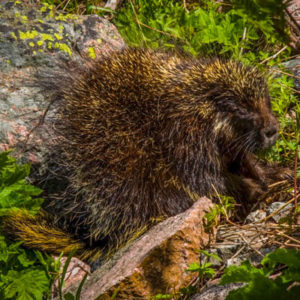 Happy April Fool’s Day! Myths about the natural world abound, and we don’t want you to be the fool this year! Have you ever wondered if bats are really blind, or if toads can give you warts, or if porcupines can shoot their quills? Well, we are here to debunk these legends and get to the bottom of things.
Happy April Fool’s Day! Myths about the natural world abound, and we don’t want you to be the fool this year! Have you ever wondered if bats are really blind, or if toads can give you warts, or if porcupines can shoot their quills? Well, we are here to debunk these legends and get to the bottom of things.
Many of us have heard the phrase “blind as a bat,” and although it is true that many bats use echolocation, or the bouncing of sound waves, to navigate, bats actually have great vision. Their eyesight is comparable to that of humans. With over 1,300 species of bat, their individual vision abilities are linked to the ways they search for food.
Bats that hunt, such as the little brown bat, and the long eared bat found in Colorado, use both echolocation and sight to find food and avoid obstacles. Many fruit bats, who drink plant nectar rather than hunting, tend to use only sight, and some can even perceive ultraviolet light when searching for flowers. So when you’re feeling ready to call your friend “blind as a bat,” you might want to rethink the amazing vision of this species.
What do you say when you meet a toad? Warts new? This zinger gets us thinking about toads and whether or not they will give you warts. Now this is one of these myths that you may have heard about growing up while catching critters creek side. But once again, this myth has been busted! There are actually no species of amphibians that can give humans warts.
The little wart-like bumps covering a toad’s skin are actually granular glands that secrete a slew of both poisonous and antibiotic compounds. These glands act as a defensive barrier between the toad and potential predators and pathogens. So although a toad will not give you warts, certain species may cause a rash or skin irritation upon contact. It is still advisable to wash your hands after touching one of these slimy fellows.
Now be careful not to let the undeniable cuteness of our last animal, the porcupine, fool you into a quick cuddle this April 1st. You may have heard that when porcupines feel threatened, they will triumphantly shoot some of their 30,000 quills from their back, straight into the wake of an approaching predator. Although porcupines do utilize their quills as a main source of protection, they cannot shoot them. Instead, the slightest touch can detach dozens of barbed quills into the approaching predator. Ouch!
But more often than not, porcupines actually tend to poke themselves with their quills rather than a predator. As lovers of climbing trees and chewing on bark, porcupines have a clumsy tendency of falling out of trees, and sticking themselves with their own quills. Luckily, porcupine quills contain an antibiotic coating which protects porcupines from developing an infection from these accidents. But what’s a porcupine to do when they need a hug? This is a conundrum that even this All Fool’s day cannot solve.
What an adventure in discovering the truth behind these hoaxes in the natural world. Maybe it’s given you some inspiration to delve deeper into demystifying the beautiful environment and creatures of the Rocky Mountains. Now, ever wondered why the Rocky Mountains are so funny? It’s because they are hill-areas.
Rachel Swanwick is a naturalist at the Walking Mountains Science Center in Avon.









